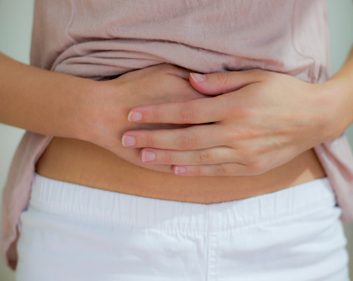Could you be suffering from endometriosis?
This painful condition has a variety of different symptoms. Could it be the cause of your discomfort?

Source: Best Health magazine, November/December 2013; Image: Thinkstock
Endometriosis comes from the Greek endon for within and metra for uterus. Normally in premenopausal women, tissue builds up inside the uterus every month in order to nourish a baby should the woman become pregnant; with endometriosis, that tissue grows outside of the uterus as well, mainly in the abdomen. This painful condition is still shrouded in misconceptions, mainly because its symptoms can vary so much from woman to woman. That can mean a woman may go for years without being properly diagnosed.
Some women have symptoms, including heavy and painful periods, right from their teen years. However, others don’t develop pain or other symptoms until later in life. Many have no idea they have endometriosis until they have fertility issues.
No one knows for sure what causes this condition. One theory is that all women have retrograde menstruation’when menstrual tissue goes back up the Fallopian tubes and into the pelvis’but that some women have issues with their immune systems that prevent them from flushing the tissue out. A 15-year study published in 1993 found that monkeys chronically exposed to various levels of dioxin (a toxic chemical by-product found in the environment and the food chain) over four years had higher incidence and severity of the condition 10 years after exposure.
The most common symptoms
Pain: Up to 80 percent of women with endometriosis experience pain. That’s because, along with the normal shedding of the uterine lining during their periods, the endometrial tissue growing outside of the uterus also sheds. But unlike the lining that exits your body through the vagina, this tissue has nowhere to go’so it causes inflammation and builds up into lesions. These attach themselves to the bowels, cervix, ovaries and other parts of the abdomen, and lead to pain during intercourse, bowel movements and ovulation, as well as lower back pain’even when you’re not having your period. Severity of pain ranges from mild to severe and is based on many factors including a woman’s age, and the location and extent of the lesions. A 2010 survey of 107 women with endometriosis published in the journal Fertility and Sterility found that most women experienced pain that got in the way of regular activities such as work, household chores, sex and sleeping.
Infertility: Difficulty conceiving can be a symptom of endometriosis, and in many cases women are diagnosed with the condition only when they start to investigate the cause of their infertility. About 30 to 40 percent of women struggling with infertility may be diagnosed with endometriosis: Lesions and scarring may affect the function of the Fallopian tubes and other reproductive organs. As well, the condition could be causing inflammation that disrupts the reproductive system overall. In particular, women with endometriosis have more ovarian cysts than women who don’t have it. Ovarian cysts cause inflammation, which leads to an earlier decline in the number of eggs in the ovaries’meaning a woman may struggle to get pregnant. In these cases, Dr. Christina Williams, a gynecologist with the
BC Women’s Centre for Pelvic Pain & Endometriosis in Vancouver, says they may need to turn to IVF to conceive.
However, says Williams, when the prognosis of their endometriosis is good (for example, it’s not affecting the ovaries), women have an 80 to 90 percent chance of getting pregnant after having laparoscopic surgery to treat it ‘ and can start trying to conceive about one to two weeks after surgery. If a woman is still unable to get pregnant after laparoscopic surgery, fertility doctors will try ovulation drugs, intrauterine insemination or IVF.
Fatigue: Women with endometriosis often feel tired. Dr. Kay Lie, a Toronto-based gynecologist who specializes in the condition, says many women with endometriosis may have thyroid problems that cause fatigue. Even when that is ruled out or treated, they can still feel tired simply because they are always coping with pain. ‘If they get pain relief, the fatigue may get better,’ says Lie.
The challenge of diagnosis
It takes the average woman with endometriosis between seven and nine years to be properly diagnosed, and during that time she will probably see five or more doctors to figure out what’s wrong, according to the 2010 survey in Fertility and Sterility. That’s because many family doctors are not well-informed about the disease, and because it affects women differently, starting at different stages of life and causing various degrees of pain.
A doctor with experience in the condition can diagnose it by taking a history and doing a pelvic and rectal exam. ‘You can feel the scarring. When you touch the cervix, the patient jumps,’ says Dr. Sony Singh, director of minimally invasive surgery in the department of obstetrics and gynecology at The Ottawa Hospital.
After an internal exam, some doctors confirm the diagnosis with ultrasounds or, in more complex cases, an MRI. But the best way to get a full look at the extent of a woman’s condition, and to see where the lesions are located, is through laparoscopic surgery. In this procedure, the surgeon looks inside the pelvis via a thin scope inserted through a small incision at the belly button, and makes another small incision in the abdomen where a probe is inserted so the pelvic organs can be moved to give the surgeon a better view. The woman is under general anesthetic throughout. This procedure is usually used in combination with the treatment options described below.
Treatment options
Diet and exercise: Before starting on hormones or contemplating surgery, Williams suggests exercise and dietary changes. Victoria-based registered dietitian Areli Hermanson’who works with women with endometriosis, many of whom are trying to get pregnant’recommends a healthy diet of whole grains, lean meat, fruit and vegetables; and limited caffeine, alcohol, sugar and processed foods.
She says this diet can help to moderate estrogen, control inflammation and help the liver, which processes hormones. ‘Many women see rapid changes once they change their diet,’ says Hermanson.
Some studies confirm this idea, including a 2010 U.S. study from the Brigham and Women’s Hospital, which found that in a group of more than 70,000 women, those who ate a lot of trans fats had higher endometriosis rates than those who ate a diet rich in omega-3s. Exercise also helps, by increasing blood flow to the reproductive organs and moderating estrogen levels. A 2003 study published in the American Journal of Epidemiology found women with endometriosis who did high-intensity exercise had a 76 percent reduced risk of developing lesions on their ovaries.
Hormones: Doctors may start by treating the pain and inflammation with ibuprofen. If that’s not enough’and the woman is not trying to get pregnant‘hormone-based medicines such as low-dose birth control pills containing both estrogen and progesterone will be prescribed (these are usually taken continuously so a woman rarely has a period). Progesterone prevents endometrial tissues from showing up in the pelvis and helps break down lesions, so doctors also treat patients by prescribing birth control with synthetic progesterone such as Depo-Provera injections or a birth control pill called Visanne. But not every woman tolerates hormones well, and progesterone-only treatments in particular can cause side effects such as weight gain, mood changes and lowered bone density. ‘We don’t know the long-term effects of these drugs, as they have not been studied long term. [Medical experts] think short-term treatment is better,’ says Williams.
Surgery: Women who have trouble taking hormones or who want to get pregnant may opt for surgery: Right after locating lesions during general-anesthetic laparoscopy, the surgeon will use the same belly-button incision to cut away endometrial lesions, and additional incisions in the lower abdomen to cut away or destroy them (usually using electrical current, a laser or ultrasonic energy). This surgery can take four to five hours if there are numerous lesions, and recovery takes one to four weeks.
Lesions will eventually come back, and about 30 percent of women need surgery again in five years. In severe cases where the pain cannot be controlled and the woman does not intend to have children in future, she might decide to have a hysterectomy and, if the ovaries are affected, an oophorectomy, as endometriosis’s symptoms stop completely in full menopause. But this is a last-ditch option, as these women will need to cope with the side effects of going into sudden menopause and may need hormone replacement therapy.
What’s new?
The BC Women’s Hospital & Health Centre has set up the first clinic in Canada that specializes in endometriosis care at its BC Women’s Centre for Pelvic Pain and Endometriosis. Williams says it involves a multidisciplinary team, including a physiotherapist who helps women with pelvic floor problems’their muscles can be in spasm from coping with pain, which can cause more pain, particularly in the lower back or during sex. The clinic is also developing better ways to treat patients mentally and physically. Williams hopes it will serve as a model for other clinics across the country to better help women with the condition.
This article was originally titled "Endometriosis" in the November/December 2013 issue of Best Health. Subscribe today to get the full Best Health experience’and never miss an issue!




